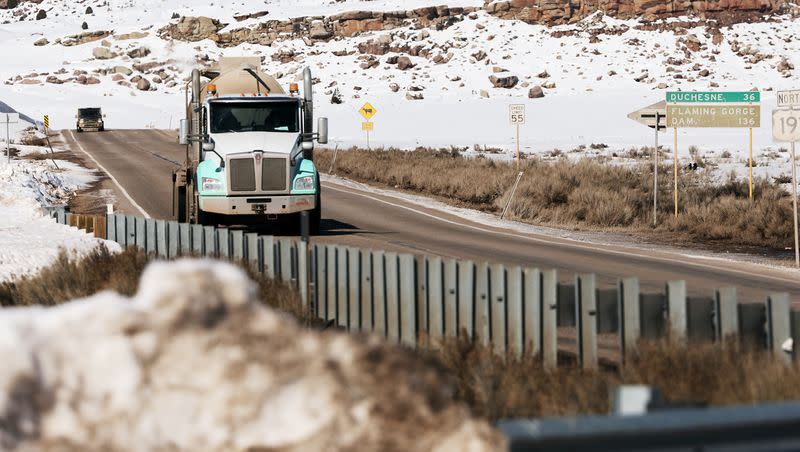Opinion: The dangers of a Uinta Basin Railway

On June 1, boosters of the Uinta Basin Railway wrote an op-ed to “debunk” criticism of the project. However, an objective look at the facts shows that the railway amounts to little more than a massive oil pipeline on wheels threatening Utah, Colorado and downline communities with pollution, spills, hazardous waste and climate havoc.
Of course railroads are used every day, and they often solve transportation problems. But the only problem this railway will solve is how to make oil companies richer. The federal Surface Transportation Board concluded that the railway was designed to serve a single purpose: quintupling oil production in the Uinta Basin. Trains leaving the basin are not predicted to carry anything in commercially significant quantities but oil (up to 5 billion gallons a year) that would not otherwise be drilled, while trains returning to the basin are not expected to carry anything in commercially significant quantities but fracking sand to help with that drilling. While the board stated other products “might” be transported, the agency concluded that transporting freight besides oil and sand was not “reasonably foreseeable.” The railway’s contention that it will “diversify” the local economy or carry all manner of other freight is simply make-believe.
Railway backers allege that hauling Uinta waxy crude will be as safe as hauling birthday candles. This is more make-believe. They fail to mention that this special wax comes with a hazardous materials safety sheet that warns that the crude is “suspected of causing genetic defects,” “may cause cancer,” “may cause damage to organs (liver, kidneys, blood, nervous system and skin) through prolonged or repeated exposure” and is “very toxic to aquatic life with long lasting effects (long-term, chronic).” The Surface Transportation Board’s analysis concluded that “waxy crude oil may persist in the environment for a longer time relative to other non-waxy crude oil.”
And that oil may burn in an accident. The Surface Transportation Board stated, “For larger spills (e.g., spills involving five or more loaded rail cars), the likelihood of an accident having sufficient energy to yield an ignition would be greater, i.e., closer to 50 percent or more.”
In short, such toxic “candles” would pose environmental and health threats if damaged rail cars were to release them into the environment. That’s inevitable, because if we’ve learned anything from the East Palestine, Ohio disaster earlier this year, it’s that train cars derail, crack, and release dangerous, polluting cargo.
Related
Uinta Basin Railway project chugs forward despite controversy
New details from Ohio train derailment revealed in new report
There is ample reason to doubt the railway’s claim that it would actually transport Uinta waxy crude in its solid form. When Uinta Yellow Waxy Crude falls below 120 degrees Farenheit, it is a solid that cannot be pumped from the ground, transferred, or refined. Yet the railway’s boosters claim that once the hot waxy crude is loaded into a tanker car, they will let it cool and solidify before shipping it, reducing its risk in the event of a spill.
This would be a radical departure from current practice. When Uinta crude solidifies, it forms a paraffin and asphaltene sludge that binds to and corrodes container walls and, over time, clogs anything it is carried in. That is why shippers scrupulously avoid letting it solidify in transit. Hauling solid Uinta crude in tanker cars is so expensive and impractical that it calls into question the commercial viability of the railway, which is in doubt even if it were to follow standard business practice. If the railway’s backers actually have discovered a commercially viable way to haul solid crude in tanker cars, they need to publicly disclose the details to ease the fears of all those who would suffer if a 120-car oil train were to derail and spill into the Colorado River.
Federal regulators predict that a two-mile-long oil train carrying millions of gallons of oil will derail every year, and lead to a spill every four years. This apparently doesn’t worry the railway’s backers.
Up to five times a day, loaded oil trains would tiptoe down the steep, unstable slopes and sharp bends of Utah’s Indian Canyon, crossing its stream over 400 times, then tackle Colorado’s mountainous terrain, including narrow canyons without road access, and then follow the Colorado River for well over 100 miles. More than a dozen communities near the rail line oppose it because they know that accidents are inevitable, spills will not be easy to clean up, and they would threaten the livelihoods of their residents, which depend on angling, boating and clean water.
The sunny picture of the railway that its backers paint ignores the air pollution and climate impacts of producing, refining and consuming all that oil. Oil production in the Uinta Basin causes smog worse than Los Angeles on some winter days. Quintupling the basin’s production, as the railway intends, would make its smog problem that much worse.
Nearly all of the oil would be transported to areas in Texas and Cancer Alley in Louisiana for refining, whose communities are already heavily impacted by the pollution created by the fossil fuel industry. No federal agency has ever assessed these harms, or asked these communities if they’re prepared for more. The Seven County Infrastructure Coalition certainly didn’t.
The Surface Transportation Board’s analysis concluded that producing, transporting, and burning the railway’s extra Uinta crude could also unleash 56 million tons of carbon dioxide per year, an amount that would cause more than $2.5 billion in global damage annually.
So when oil train backers say they are correcting misrepresentations about the Uinta Basin Railway, beware. Such “corrections” blend crude oil with snake oil.
Malin Moench spent 37 years analyzing economic and legal issues pertaining to public utilities and logistics for the federal government. Now retired, he works as a volunteer for various nonprofits devoted to protecting pubic health and the environment.

